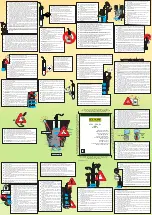
5. HEALTH & SAFETY INFORMATION
– Wear isolating footwear and gloves that are in good condition, i.e. without holes.
– In hazardous conditions of increased electric shock always ensure a second person is
present in case of accident.
– Never change electrodes with bare hands or damp gloves.
– Keep welding cables away from power cables.
– Regularly inspect the condition of the welding, earth, and power cables for signs of
damage.
– Do leave machine unattended and remove plug from socket when not in use.
– Do not use welding cables unsuitable for the amperage.
– Ensure earth clamp is adjacent to weld seam, secured to bare metal and when not in use
is insulated for safety.
– Keep all equipment well maintained.
– The operator shall prevent gas cylinders in the vicinity of the work piece from becoming
part of the welding circuit.
Fumes & gases can be harmful:
– The welding process generates hazardous fumes as a by-product. Inhalation of these
fumes is hazardous to health.
– Keep your head away from the weld to avoid breathing the fumes.
– If welding in confined spaces ensure adequate ventilation and use a fume extractor.
– Welding fumes displace oxygen. Danger of suffocation.
– By-products of welding can react with other chemical vapours to produce a
toxic/explosive environment.
Welding can cause fire or explosion:
– Arc welding and allied processes can cause fire and explosions and precautions shall be
taken to prevent these hazards.
– Before starting a weld ensure the area is clear of flammable materials.
– Remove any inflammables to a safe distance, especially substances likely to generate a
dangerous vapour.
– The welding arc can cause serious burns. Avoid contact with skin.
– Sparks and molten metal are cast out during welding. Take precautions to prevent fire
igniting and wear protective clothing.
– Sparks and molten metal can pass through gaps. Be aware that fire can start out of sight.
Flammables in a locked cabinet may not be safe.
– Do not weld pressurised containers.
– Do not weld tanks, drums or other vessels until they have been correctly cleaned/prepared
for welding.
– Always have appropriate and fully maintained fire fighting equipment suitable for the
materials used and for use in electrical environments available in close proximity at all
times.
– Keep clothing free from oil and grease.
– Wear hat, flame-proof apron, woollen clothing, gloves, long sleeve tops with closed neck,
trousers (without turn-ups) to cover non-slip boots.
– Protective head and shoulder coverings should be worn when overhead welding.
8
Summary of Contents for MIG100GG
Page 22: ...22 NOTES ...
Page 23: ...23 NOTES ...









































